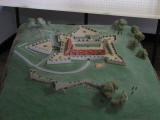Part VII - Fort Ticonderoga, Lake George,
Saratoga Battlefield
On our last tour days, we visited Fort Ticonderoga, cruised Lake George on a
century-old vessel, and toured the revolutionary war battlefields at Saratoga.
We had been told that Columbus Day marked the traditional "end of leaf
season". That proved to be absolutely true in Lake George - the town was
almost vacant, and nearly every store was closed. It was a remarkable
change from the relatively crowded scenes just a few days earlier.
We said our good-byes to most of our group at the Albany Amtrak station.
About ten of the tour members will be training with us to Chicago this evening,
so we're spending the afternoon with them at the station while waiting for our
train.
 |
 |
 |
 |
| Fort Ticonderoga changed hands numerous times.
It was originally built by the French in the 1750s, then bouncing
between British and American control during the American Revolution. |
Over 100 cannons arm the Fort's perimeter... |
...which overlooks and guards Lake Champlain. |
A demonstration of Revolutionary War-era clothing and
shoe construction. |
 |
 |
 |
 |
| More cannons... |
...and more cannons aimed in every conceivable
direction. |
The parade grounds in the interior of the Fort.
This represents a 180 degree view. |
This model of the Fort clearly shows its layout. |
 |
 |
 |
 |
| I noticed these interesting defects in the windows... |
...which create interesting visual effects when
looking from the inside. |
Powder horns had elaborate decoration. This one
is clearly labeled for the October 11, 1776 battle of Valcour Island,
with then General Benedict Arnold. |
After touring the Fort, we drove through the town of
Ticonderoga and explored this delightful city park. |
 |
 |
 |
 |
| Elwin LeFevre and Terry at the covered bridge in
Ticonderoga. |
Ticonderoga. |
A lunch stop at the Algonquin Restaurant, on Lake
George just North of the town of Lake George. |
The end of the fall "leaf season" is typically marked
by Columbus Day, and the town of Lake George is nearly vacant today.
This picture also shows some nice fall colors along Main Street! |
 |
 |
 |
 |
| So sad....even Ben & Jerry's was closed today.
If you look closely (just below the ice cream cone), you can see Mo's
disappointed expression reflected in the shop window. |
I found this campaign brochure in a coffee shop in
Lake George. Dad will know why I thought it was interesting. |
The m/v Mohican on Lake George. This vessel was
originally built (as a steamer) in 1907. It was converted to
diesel power in 1945. In 1966, the vessel's wood and fabric
superstructure was replaced with steel. |
Mo is reading her Kindle on the deck of the Mohican
as we sail up the lake. |
 |
 |
 |
 |
| Nice fall colors on the lake. Today's overcast
skies mute the colors quite a bit. |
The Sagamore Hotel, originally built in 1883.
It is the last of the "Grand Hotels" that dotted the shores of Lake
George in the early 1900s. |
Cruising on Lake George |
Vibrant colors at a City Park in Lake George. |
 |
 |
 |
 |
| At the Saratoga Visitor's Center, the (British)
Trophy Cannons surrendered here are engraved with "Surrendered by the
Convention of Saratoga, 1777" |
Saratoga marked the first time in history that the
British Army had surrendered in battle. The British defeat here
allowed the fledgling United States to gain allies in France, Spain, and
The Netherlands. |
I thoroughly enjoyed this sign on a soda vending
machine outside the Saratoga Visitor's Center. |
Carl is explaining the logistics of one of the
battles at Saratoga. We're at the location where American troops
lined up at Bemis Heights overlooking the Hudson River, to secure the
route the British intended to take on their march to Albany. |
 |
 |
 |
 |
| Another view from Bemis Heights. The American
fortifications forced the British to engage here, rather than continue
on to Albany. |
The battlefield markers (blue) indicate where the
American lines were formed... |
...and the red ones show where the British troops
(Redcoats) lined up. This location is particularly significant -
at the far end of this line is the opening in the British lines through
which Benedict Arnold rallied the American troops. This charge by
Arnold was the beginning of the end of the British engagement at
Saratoga. |
Interesting....all I remember from my US History is
that Benedict Arnold was a notorious traitor. I had forgotten, or
perhaps never learned, that before his act of high treason, he led the
American forces to victory on one of the most significant battles of the
Revolutionary War. This monument honors his contribution here.
The boot is symbolic of the wound that Arnold received during the
battle. |
 |
|
|
|
The inscription reads "In memory of the "most
brilliant soldier" of the
Continental Army who was desperately wounded on this spot the sally port
of BORGOYNES GREAT WESTERN REDOUBT 7th October, 1777 winning for his
countrymen the decisive battle of the American Revolution and for
himself the rank of Major General". In accepted military
tradition, (the traitor) Arnold's name is never mentioned anywhere on
this monument to his contribution to the Revolutionary War. |
|
|
|





























